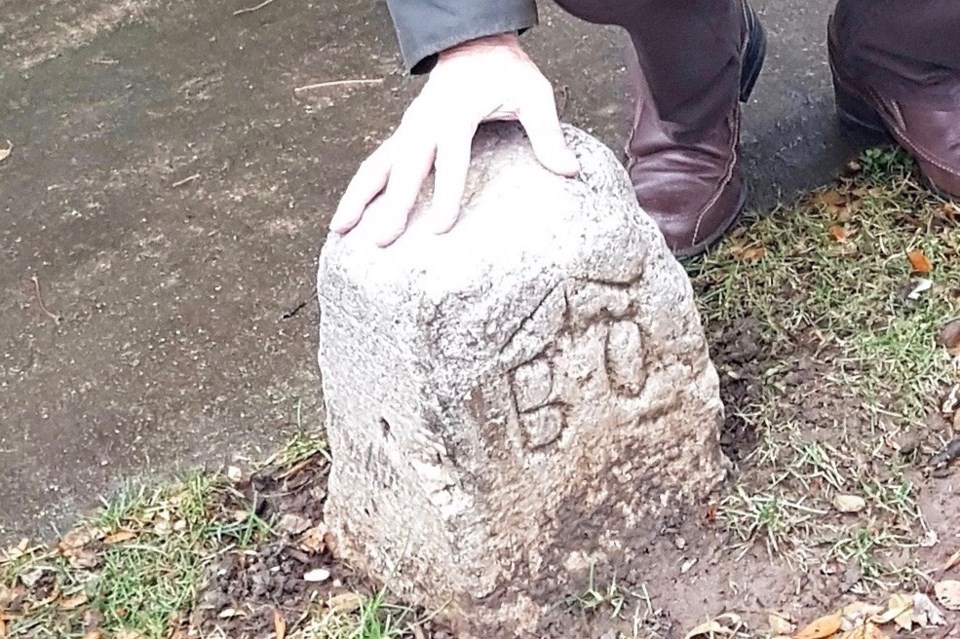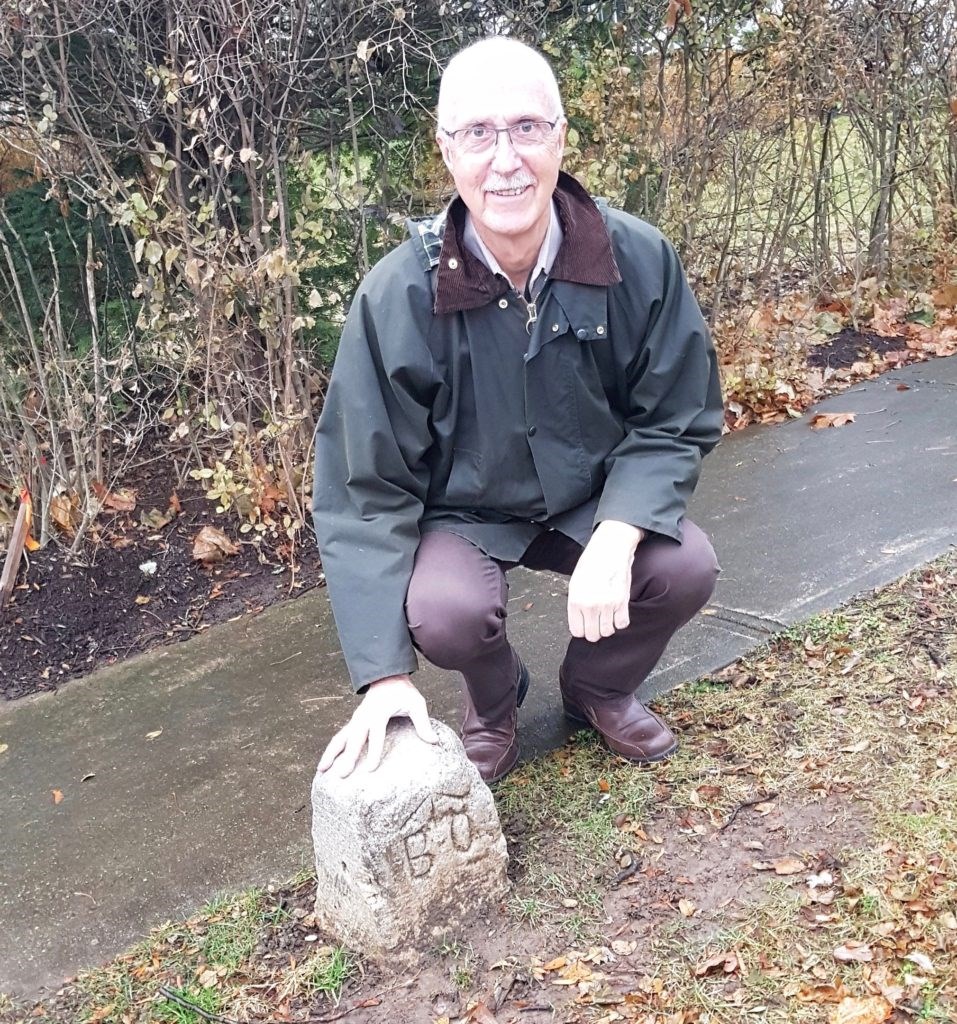
Ted Rumble, a retired orthopaedic surgeon, has a long-standing interest in history, particularly military history.
When he moved to Niagara-on-the-Lake, he could see a stone across the road from his house at the corner of Prideaux and Simcoe Streets. “One day, my curiosity got the better of me, and I looked more closely,” the board member of the Niagara Historical Society told those who joined the museum’s weekly webinar last Thursday. The presentation was his second in a series of lectures which includes a wide range of topics, his relating to his research on what he discovered to be 200-year-old ordnance boundary stones.
The nine-inch square white limestone blocks, engraved with the initials B O and an arrow on the front, and a number on the back, he said, “are some of the oldest historical artifacts in the Old Town.”
In 1807, the town was laid out in the typical British grid, with the Garrison Military Reserve and Fort George, known as the Commons today, and the Mississagua Reserve, which is today the golf course, with half of it then privately owned by a wealthy businessman and investor. In 1823, in what Rumble calls “the great swap,” the businessman traded his part of the Mississagua Reserve to the British in exchange for some prime land on the Garrison Reserve.
“The first reference to the ordnance boundary stones that I found is in his letter written in 1823,” he said.
The stones were placed around the two military reserves by the British army’s Royal Engineers, to mark the boundaries between town land and military reserves, explained Rumble.
The arrow was the symbol used by the Board of Ordnance (hence the B O engraved on the stones) which became the custodian of all British military property around the world.

The origin of the broad arrow is a matter of some discussion, but his favourite story, he said, is that the Royal Navy, sent scouting parties out into the woods to find trees that would be suitable for masts on the navy warships. A suitable tree was marked with an arrow pointing upwards, and there were severe penalties for anyone who cut down a tree that was marked with the board arrow, he said.
There were originally 37 stones, but 21 have gone missing, with 16 left that Rumble has been able to find in the town today.
One of the stones that still exists is number 3, in the middle of Butler’s Barracks. “It is very much at risk from riding lawnmowers, and it’s also at risk during the Kinsmen car show, which is held every August, when it’s surrounded by about 50 cars. It’s amazing it hasn’t been knocked down by now.”
Boundary stone number 4 took Rumble a long time to find. It was placed in 1832, and when the Rand Estate wall was constructed in 1908, it was built on top of the stone, and now looks to be part of the wall.
Stone number 5 was located close to the entrance to Heritage Trail, which was once railway land, said Rumble. “It is sunk down quite far, but it’s still in good shape.”
Other boundary stones have been found under a hedge also sunk down, another tilted by tree roots but in pretty good shape, and another covered with moss.
Stone number 21, he said, is at the entrance to Queen’s Royal Park, with the gazebo in the distance. It’s sunk down nearly flush with the ground, “and with a few more years, it’s going to disappear, never to be seen again,” said Rumble.
Stone number 22, at Front and Simcoe Streets near the golf cart path “is also at risk of damage from riding lawn mowers, “as it’s completely unprotected.”
The stone that Rumble can see from his house, number 23, “was struck by a riding lawn mower last fall and is broken across the base. You can lift the top of the stone off. It is in urgent need of repair before it deteriorates any further,” he said.
Stone number 26, best approached from the ninth tee of the golf course, is probably the best preserved of the remaining stones, with engraving and bevelling that is easy to see. There is a lot of moss on the north side of the stone, “which confirmed what I learned in Boy Scouts, that moss grows on the north side of trees,” said Rumble.
Stone number 27 is also in pretty good shape, after being moved from the property line of the Charles Inn to the junior commissariat near Butler’s Barracks, he said. He hasn’t been able to discover why it was moved, and would like to see it back on Queen Street where it belongs.
Two of four stones that mark the corners of the military reserve can still be seen, one in a garden in Simcoe Park at King and Byron Streets.
Another stone totally unprotected was recently damaged by a backhoe during obstruction at the corner of Johnson and Nassau Streets.
Rumble has asked the Town to recognize, restore, protect and celebrate the stones, which would require a partnership of the Town, Parks Canada, and the museum, he said.
The Friends of Fort George have already agreed to help.
Although there are British ordnance stones around the world, there is no other place that has 16 of the stones still in place.
The stones, he said, “are a unique historical treasure which shed a light on how our town came to be the way it is today, with beautiful green spaces such as Simcoe Park, Queen’s Royal Park and the golf course right in the middle of the Old Town.”
Rumble said it took him more than a year to find the 16 stones. “Like many people in Niagara-on-the-Lake, I like to walk, and would focus my walk on hunting for the stones.”
They were hard to find, especially the ones that have sunk down in bushes or hidden under mulch.
He said he doesn’t know how deep they go. Some have sunk below the ground. “I’m hoping one day we can get ground-penetrating radar and look below the ground for them.”
He is hoping the Town will designate the stones as historically important, and hopefully also restore and preserve them.
He will be making a presentation to council soon to ask for that to happen, he said.
He spoke to council last December, and several councillors indicated support for Rumble’s requests, but offered differing alternatives on how to deal with them. One option was to hand the matter over to a committee that was charged with looking into the preservation of Butler’s Burial Ground, also on Parks Canada property. Others suggested the Municipal Heritage Committee and town staff should be involved, and the result was it would be discussed with staff how to best move forward with his request.
At the end of his lecture a suggestion was made that a walking tour would make a good exploration of the ordnance stones.
Rumble says it would be more than a six-kilometre walk, and could maybe instead be a tour of a collection of stones, but the distance would be perfect for a bicycle tour.


